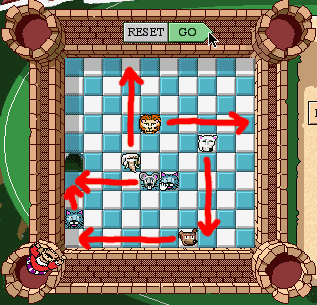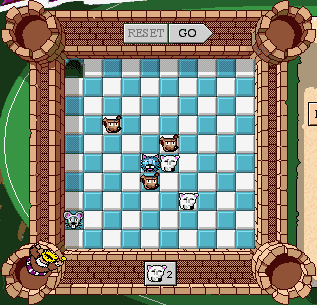Segments: Slices from the Macintosh Life
Violence is Golden
There’s money to be made from computer game violence. Much of that money is being made by complaining about it. One of the big winners is Lt. Col. Ret. David Grossman, with two books selling well and a quite successful consulting business called (I am not making this up) the Killology Research Group. One reason the gaming community is up in arms...excuse me, I mean protesting vociferously...is that, well, let’s face it, he’s almost got a valid point.
Here’s a valid point: it is not wise, kind, or loving, to immerse children in an atmosphere of violence, be it films, computer games, or real life.
Here’s Col. Grossman’s point: violent video games (he calls them “murder simulators”) turn kids into killers. They aren’t just a Bad Thing, they are the Worst Thing.
The Colonel is getting lots of press and air time, as our society seeks scapegoats for our troubled times and the apparent increase in youth violence. He only gets weird when (and remember, this guy is a Ranger and an ex-professor of psychology at West Point), after putting video game violence at the head of the Bad list, he waxes sentimental about the benign—possibly even helpful—pleasures of actual gun handling. You’re going to raise a murderer if you let your kid play Unreal on the Internet; instead, you should take him and your Glock to the local pistol range and have him put a few rounds through some human silhouettes. Playing Doom teaches children how to kill, but playing paintball teaches them sportsmanship. Playing Deer Hunter desensitizes children to violence, but actually hunting deer...that’s just harmless fun.
Fortunately, there is plenty of harmless fun available in the Mac gaming world. There are games truly suitable for all ages, games that will make you think, games that will make you giggle. These games won’t solve all your parenting woes—time spent playing games is time spent not doing homework—but at least the media won’t blame you for raising an iMac-wielding psychopath. Just kidding.
Skittles 2
Skittles2 is the best of the better-than-Tetris games. Things (things called Skittles in this case) come in from the top and fall to the bottom. Your task is to get rid of them before the play area fills up with things. Chances are, this is not an unfamiliar concept to you.
Skittles stands out thanks to its clever rethink of that concept and its splendid execution.
Skittles, which come in a variety of colors, evaporate whenever four (or more) of the same color touch each other. They appear in pairs, which can be rotated or moved side-to-side by deft manipulation of your arrow keys. Simple, eh?
The result is a game with a huge ratio between Ease of Play and Difficulty of Mastery. In six minutes, you can play a decent game. In ten hours, you’ll still be improving your skills.
Here’s a partial and scrunched-down Skittles screenshot, to give you an idea of its look and feel. The Real Thing is bigger, of course. That’s me playing on the left, getting my pants beaten off me by the game’s AI, playing on the right.

A pink and purple pair have appeared. I could pivot the pair as they plummet, so the pink precedes the purple as they plow into the pile, but that would be too much alliteration for one paragraph of prose.
Instead, I’ll nudge them two columns to the right. The red arrow does not appear in the game, that’s just me showing my strategy in a graphical manner.
Note how the skittles hook up when they contact each other—it makes it easy to keep track of them. There’s a group (cluster? gaggle? pride?) of purple skittles about mid-field, begging for companionship. When the descending purple skittle lands on the clear skittle, there will be four purple skittles briefly conjoined, then—poof—they will evaporate in a shower of purpleness. With those four skittles gone, the skittles above will drop, including the pink skittle that came riding in on top of the latest purple skittle.
So then there’ll be a pink skittle next to the upper pink skittle of that group of three on the bottom right of that window. Poof—no more pink skittles, so the green, purple, and clear skittles above the tower of three pink skittles will drop, creating a group of four green skittles, and poof, four more skittles gone to Skittle Heaven.
Too violent for you? Remember, no skittles were harmed during the development of this game, it’s only a simulation.
Now then, why does the computer have more points than I do? I deserve to be ahead, right? I have fewer skittles on my board, and it looks like Skittles 2’s artificial intelligence is going to run out of room on the board before I do.
That’s because I’m playing a conservative game, and concentrating on keeping my stacks low, where the computer is playing for the dramatic (and high scoring) chain reactions such as the one I just described. The points pile up when you blast twelve or twenty or more skittles at once.
This static picture of Skittles2 doesn’t show the attention to detail that makes it an outstanding game. For example, when skittles are moving, you can see they are slightly reflective. They also pick up a bit of smoke damage when nearby skittles explode.
In short, Skittles is worth the 7.5 MB download for the demo, and if you like the demo, it’s worth the $25 registration for the full tilt boogie version. The developer is John Stiles, one of the Mac community’s serious and successful shareware developers.
CastleMouse
A clever concept, this game is rather reminiscent of Martin Gardner’s Mathematical Games column in Scientific American (yes, I’m dating myself). The object is to chase the mouse into the hole. All creatures here take rook moves (no diagonals). Once they get started, they keep going until they hit a wall, bump into another creature, get scared (more about that later), or, in the case of the mouse, fall in the hole.
To move the mouse, you put a cat next to it. That frightens the mouse and away he/she/it goes. How do you move a cat? Put a dog next to it. Dogs are frightened by bears, which are frightened by lions, which are frightened by elephants. Oh yes, and elephants are frightened by the mouse.
Here’s an example. To start this game, click-and-drag the cat (the free one on the lower castle wall) into a square. Then click “GO” and see what happens.

Give up? Don’t be ridiculous, there are only 94 places to put it (you can’t put a creature on top of another creature). In practice, there are only four places to put the cat where it might do some good. The cat only scares the mouse, so the only place the cat can start things off is next to the mouse.

Here’s the solution. Move the extra cat (the one with the hand icon on it) to the square just east of the mouse. That scares the mouse, which goes west until it bumps into the wall. On the first square of its mously journey, it scares the elephant, which heads north, scaring the lion, which scares the bear, which goes south and scares the dog, which goes east and ends up next to the cat which was already in the picture. That cat heads north, and scares the mouse into the hole. Cheers, fanfare, victory is yours.
This is another Easy to Play/Hard to Master game, requiring no twitch skills whatsoever. It is purely cerebral, and can be geared to any size cerebellum. Played with one cat and two dogs, you can make a puzzle that will positively tickle a six year old (a handy rule of thumb: attention span in minutes is roughly equal to age in years). Throw in a few bears and lions, and you can play Stump the Physicist with your Mensa buddies.
Here’s an example in the adult difficulty range.

Position two bears on the playing field so that they will coerce the dogs into herding the cat into position to scare the mouse down the hole.
Too easy? Well, that’s puzzle 33 out of 300+, and they get tougher as you go along. Plus there’s a puzzle editor, and you can send your puzzles to the CastleMouse Web site and let other players to pit their skills against yours.
Actually, the tougher the puzzle, the smarter you’ll feel, because the game’s AI is strictly Alley Oop, though admittedly it’s Alley Oop after fourteen cups of Starbuck’s Mocha, tall doubles no less.
The game’s AI can solve any puzzle you give it (or prove it can’t be solved), but the technique is simple brute force. It tries everything. If the particular puzzle only has one movable creature, all it has to try is putting that piece in each square, starting at Square 00 and ending at Square 99. That’s 100 tests, and it can do that in the time it takes you to put your hand on the mouse. With two movable creatures, it tries every possible combination of placements, which is 100 times 100 tests—10,000 tests. Depending on the complexity of the puzzle, it’s hard to know if one should bet on the human or the Mac.
But with three or more movable creatures, the smart money’s on the wetware. The AI can spend much of the day processing 100 x 100 x 100 tests—three creatures require a full million tests. I always feel like the intellectual equivalent of John Henry when I can beat a PowerPC at a logic problem (not including the lay down his hammer and he died, Lord Lord part).
A 50 puzzle demo is available online, along with an over-the-Web version that runs on their server and is controlled by your keyboard. If you like it, the full version is $19.95, available for download. I haven’t been able to learn much about the development team, probably because they’re getting a lot of mail.
Pit Droids
A puzzle game from Lucas Learning, not hugely more sophisticated in concept or play than CastleMouse, but man, do those folks a Lucas Arts know graphics or what? They probably get a deal on Star Wars licensing too.
Your mission is to guide a batch of mindless automatons through mazes and hazards. Your tools are an inventory of arrows you can lay on the playing field. When a droid steps on an arrow, he goes whichever direction it points, until he hits a wall, an obstruction, another droid, or his/her/its exit hole. Sound familiar? Actually, it sounds a bit like Lemmings, but the execution is world-class, and that’s what will keep your kids focused. Though these droids are considerably dumber than, well, hamsters for example, they are just as cute and you don’t have to clean their cage.
Here is a solution to a simple Pit Droids puzzle.
The droid generator (bottom center) sends its creations northeast. I’ve redirected them north by northwest, and given them a westward arrow from which to spring into their ’droid hole, or whatever you call that thing (upper left).
Note the blurring of the leaping droid. Yep, that’s just how a real leaping droid would look on film stock. There’s no question where Lucas Learning gets its inspiration.
My favorite part of this game is the frustrated body language the ’droids portray when stymied. I took the second arrow away before the last droid got to it and...
Whoa, what’s a droid to do? Look at that cute little tyke, pondering the situation, impatiently tapping its toes, and finally turning to shake its tiny aluminum fists at me. It also jumps up and down, stamps its feet, and does everything except spit on the ground. I’m sorry this feature is disabled after the first puzzle; after that, they just crash into things and disappear.
Later puzzles have locking barriers, arrows, droids of various colors, and varicolored droid holes. I expect the Real Thing is considerably more complex, but I’ve only seen the demo, which is downloadable from the starwars.com/pitdroids site and the companion CD with many recent dead tree Mac publications. You can buy the full game online for $29.95 and there’s a $10 rebate if purchased before March 31. Since the full game comes on CD-ROM, you’ll have to add shipping—I couldn’t find out exactly how much without giving my credit card info, but there are lots of catalog retailers who can help you out.
I’ve only seen the demo, but I like it, George likes it, and you’ll probably like it too. The Web site is fun, full of entertaining PR materials, and shows how a big franchise with a big budget can sell big quantities and keep individual prices low. The Team Photo shows 31 people, and the Team Interview credits over 100 staff members who had a hand in the production, none of whom wasted their time on droid AI.
Backyard Football
Ah yes, football! The great American celebration of violence and deception. The object is to fool your opponents into thinking you’re going to do something you’re not, and if that doesn’t work, have some of your larger associates knock them flat. The guys that are good at it get “scholarships,” while the scholars scramble for student loans. The guys that are really good at it get paid millions as professional violent deceivers, and we wonder why some of them (a considerably higher ratio than among millionaire violent video game players) end up explaining how their glove got to the scene of the crime, or why they’re resting in the trunk of a car. Or take this apocryphal story of a high school coach, after the ambulance took the opposition’s soundly sacked quarterback for a ride downtown.
coach: I’m sorry it happened, it was no ones’ intention. This game is all about teamwork, about helping the team, playing a good game.
interviewer: But didn’t you tell your team to [reading from notes] “Hit Givvens so hard the first half, he won’t be able to play the second half.” You tell them to “take penalties with pride.” Should the point of this teamwork be to injure members of the other team?
coach: You call that a team? Last year we stomped those clowns 21-zip.
Backyard Football isn’t like that at all. It’s friendly, goofy fun aimed at five- to ten-year-olds, playing five on five in a simulated sandlot environment.
Here’s a photo of the players you can pick from.

I’m coach for the Mighty Fishes in this game. For my first draft choice, I’m going to take little Jerry Rice, the kid sitting next to the Mystery Player (transparent with question mark, front row). Then I’ll snag the Webber twins (Ashley and Sidney, blond girls on left of top row, right of second row down), Stevie Young (top row, red shirt), Kenny Kawaguchi (front row in wheelchair, he’s strictly two-hand touch), Dmitri Petrovich (big kid on the left), and Jocinda Smith (top row left, next to Ashley).
Now let’s see who the computer picked for the opposition.
That’s Pete, John, Keisha, Annie, Barry, Gretchen, and Luanne. A good strong team, even if only two of them grew up to be NFL stars (John Elway and Barry Sanders). No problem, I’ve got Jerry and Steve.
You don’t play a player in this game, you play the coach. You can select players to influence, and control timing of such things as the snap of the ball and when the QB chucks it down the field, but for the most part, the players run around without adult supervision. You pick their plays, but then the game characters block, run, rush, and receive without a great deal of guidance. They’re fun to watch. The AI gives a pretty decent representation of five- to ten-year-olds playing football with enthusiasm and courtesy—nobody lost his temper, nobody knocked Kenny out of his chair on purpose, but then, nobody had parents on the sidelines yelling, “Are you going to take that from that little twerp? I raised you to be a man, for cryin’ out loud!”
Sadly it’s too big and complex a game for a reasonable sized demo, so you’ll need to screw up your courage and invest $19.95 for the CD. I enjoyed it, and I’m older than ten. It’s a major production, and the publisher reportedly has a million dollars invested in marketing alone, which is enough money to keep an NFL rookie in women and steroids for an entire season. This game may be a better investment.
Actually going out and playing is better exercise, but sometimes it’s raining, and sometimes there aren’t enough kids to make two teams, and sometimes you’re better off avoiding the big kid who thinks the fun part of the game is trampling little kids.
Monster Maker
There’s no such game, at least not reviewed here.
None of these four games will make your kid into a monster. I don’t even think the NFL makes monsters, though it appears to be an attractive environment for the occasional monster who slips in. Likewise, I think monsters young and old are attracted to violent computer games, as are a far larger number of non-monsters.
I was quite impressed with the Colonel’s first book (ON KILLING: The Psychological Cost of Learning to Kill in War and Society), and now I fear it was because I knew next to nothing about the subject. Now with his second book (Stop Teaching Our Kids to Kill: A Call to Action Against TV, Movie and Video Game Violence) climbing the charts, I wonder about my support for ON KILLING.
It seems to me that Stop Teaching... relies on half truths and apocryphal stories to drive its message home. Apocryphal stories are the tool of lazy writers and snaky politicians, and you’ll be hearing lots of them during this campaign year. It’s a polite way of saying, “I don’t have an actual example, so I’ll make one up that sounds plausible and tell you I heard it somewhere.” My story about the high school coach? I made it up, right there on the spot, but if you believe school sports are too violent, it sounds all too plausible.
If you’re interested in Col. Grossman’s views and the views of some other folks on Col. Grossman’s views, here are his Web site address, an e-mail interview on a gaming e-zine, and a book review by Steve Kent (Dec. 9) on MSNBC.
Have a good year, have fun on your Macs, and don’t let anybody else do your thinking for you. Let “food for thought” nourish, not replace, your own thought processes.
Also in This Series
- About My Particular Macintoshes · May 2012
- From the Darkest Hour · May 2012
- Shrinking Into an Expanding World · May 2012
- Growing Up With Apple · May 2012
- Recollections of ATPM by the Plucky Comic Relief · May 2012
- Making the Leap · March 2012
- Digital > Analog > Digital · February 2012
- An Achievable Dream · February 2012
- Smart Move? · February 2012
- Complete Archive
Reader Comments (2)
I absolutely loved the Skittles game and had forgotton about it until I came across your review...I clicked on the link for the game and it is no longer there. Can you tell me anything about it?
Thank you,
Leighann
Add A Comment